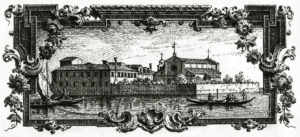An Island With No Name
July 6, 2018, Venice
Ever since my first visit to Venice as a student for a summer course at Collegio Moorat-Raphael in 1988 (if memory serves), the island of San Lazzaro has been a very special place for me. It lies at the center of nearly all my imaginings about Venice, and even when I have occasionally felt mistreated by some of its monastic denizens, the island with the famous silhouette of its bell tower has exerted a magical sway over most of what is genuinely valuable in my life. It is this sway that has compelled me to devote one of my next books to the critical history of the order that settled down on it more than three hundred years ago. Despite the many works devoted to the congregation and its rich history, remarkably little attention seems to have been paid to the history of the actual island, San Lazzaro, on which Mkhitar and his disciples carried out remarkable intellectual and religious feats. In the spirit of taking a few tentative steps in that direction, I offer below a few notes that I’ve cobbled together over the last day or two.
San Lazzaro appears to have had a “dark fate” until it was passed down to Mkhitar on that fateful day on 8 September 1717. According to one of Mkhitar’s biographers, H. Torosian, the island “served as a sanctuary for humanity’s most wretched elements: lepers, invalids in need of medical care, and mendicants.”1 For much of its history, the island seems to have gone with no name. According to Giuseppe Capeletti, from the most remote period, it belonged to the Benedictine monks of the order of Sant’Ilario of Fusina, who in the year 810 by the decree of Doge, Giovanni Partecipazio, had moved there from the neighboring small island of San Servolo, given the latter’s narrowness and its location between confining marshes.2 In 1182, it appears to have passed onto a Venetian nobleman by the name of Leone Paolini who built a small chapel and hospital to care for the city’s lepers whose numbers had increased at the time, apparently as a result of pilgrimage traffic with the Holy Land.3 In the mid-fourteenth century, the island with no name was finally called San Lazzaro. About two centuries later, on 24 May 1594 to be more precise, when leprosy was all but eliminated in the city, the Venetian Senate transferred the island’s ownership to members of the mendicant order whose members till then roamed the streets and alleys of Venice begging for alms and causing tumult.4 In 1660 it was the turn of the Dominicans fleeing Crete to settle there after a decree from the Senate.5 Like all previous inhabitants, however, the Dominicans too did not stay long on the island. As Torosian, writing more than a century ago notes with a certain pride, “it was as if the task of transforming the fate of that wretched islet and making it celebrated among all the other islands of the lagoon was left to Mkhitar.”6 As any devoted admirer of the Mkhitarist Congregation knows by now, Mkhitar received the island as a place of “perpetual abode” following a decree by the Venetian Senate on August 26 1717. He moved there from his rented house in the Castello neighborhood, not too far from the apartment I happen to have rented for this stay, on 8 September 1717. In exchange for the receiving ownership of the island, his fledgling order whose members had fled the Peloponese only two years earlier were expected to say one daily mass (also in Perpetuity) on behalf of the island’s former inhabitants, the Mendicant Friars, a tradition that was apparently kept up till the 1830s. True to Torosian’s claim, for close to three hundred years, the Mkhitar’s heirs have not only continuously inhabited the island, expanded its size by land reclamation schemes, and beautified its once ramshackle chapel, built living quarters for their monks and a museum and manuscript library housing about four thousand priceless Armenian manuscripts; they have also made this tiny mound of earth in the middle of the Venetian lagoon into a veritable center for the renaissance of Armenian culture and identity during the eighteenth century. Today, the number of monks on the island has dwindled to an all time low, and the order stands at a crossroads. The island’s history tells us that all of its former inhabitants have been there not as possessors or permanent residents but as temporary custodians. All former occupants have come and gone, usually through an edict by Venice’s governing body or the Papacy. Mkhitar’s disciples have left a deeper impression on the island’s history and lived there longer than any of their predecessors including the lepers, mendicants, or Dominicans. Given the sad times that have fallen on the order, it remains to be seen whether the island’s stubborn history of changing custodians in relatively swift succession will also apply to the followers of the illustrious Mkhitar or whether they will prove to be the exceptions. Let us hope it is the latter.
- Յովհաննէս Վ. Թորոսեան, Վարք Մխիթարայ Աբբայի Սեբաստացւոյ (Venice San Lazzaro, 1901), 295.
- Giuseppe Cappelletti, Storia Dell’Isola di S. Lazzaro e della Congregazione de’ Monaci Armeni (Venice: Tipo-Litografico di M. Fontana, 1877), 3. “Questa, da remotissima età, apparteneva ai monaci benedettini di Sant’Ilario di Fusina, i quali, nell’anno 810, per deliberazione del doge Giovanni Partecipazio, avevano abbandonato la contigua isoletta di san Servolo, perciocchè troppo angusta e tra paludi ristretta, ed ivi s’erano trasferiti.”
- Ibid., 4-5.
- Ibid., 13-14.
- Յովհաննէս Վ. Թորոսեան, Վարք Մխիթարայ, 297.
- Ibid. 298. «…բայց այդ կրօնաւորներն ալ երկար ժամանակ չմնացին հոն. կարծես Մխիթարայ պահուած էր այդ թշուառ կղզեկին բախտը բարեփոխել եւ հռչակաւոր ընել՝քան լճակին միւս կղիները։»








